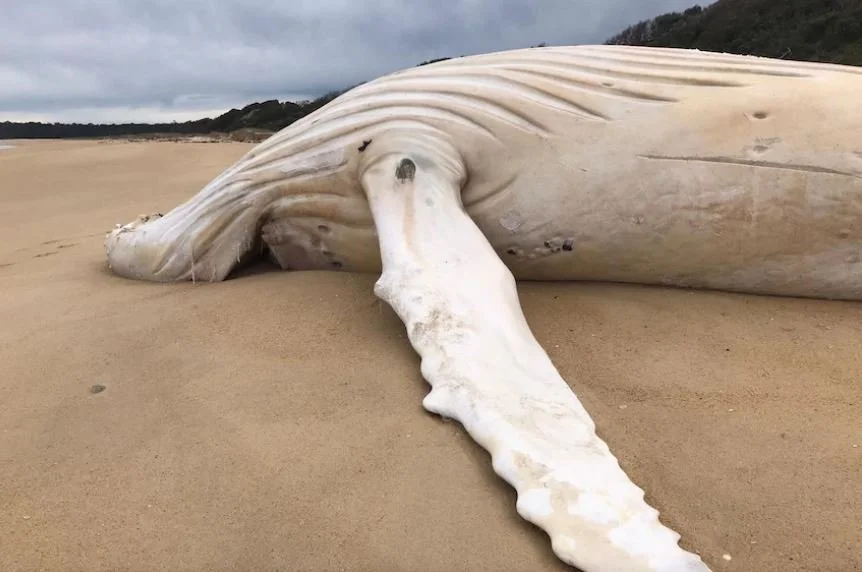Migaloo or not? Here’s what we know
Image credit: Peter Coles
A ‘white’ whale has washed ashore in Mallacoota, Victoria this weekend, prompting fears that the internationally-beloved white whale ‘Migaloo’ may have passed away along his east-Australian migration path. Both fortunately and unfortunately, preliminary data collection through citizen sighting photos and video indicates that this whale is likely not Migaloo, but a smaller female.
“We have been assessing images and videos from social media platforms, along with those submitted to MMF, and have collated several lines of evidence to confirm this is a sub-adult female humpback whale, and not the much-loved Migaloo” Dr. Kate Robb, Marine Mammal Foundation Executive Director.
“Whilst it is a relief that it is not Migaloo, it is still unfortunate to see a deceased whale. With an estimated 40,000 humpback whales migrating up the east coast of Australia, it is more likely that mortality will occur. It is however crucial to gain as much information from this deceased whale as possible, including scientific samples, skin for DNA assessment, morphometrics and dedicated body images.” says Dr. Kate.
Image credit: Peter Coles
Here’s what we know so far:
The genital region appears to be representative of a female (with mammary slits and a hemispherical lobe).
"DELWP Officers have examined images of the dead Humpback Whale at Mallacoota and have confirmed it is a sub-adult female. Migaloo is a male." - Victoria's Department of Environment, Land, Water and Planning Regional Agency Commander, Peter Bick
The whale is only ~10m long, whereas a fully grown male (such as Migaloo) would likely reach 15m+ in size.
There is evidence of skin sloughing (taphonomic effects) and degrading, with small patches of dark skin still remaining around the pectoral fin and barnacles on the throat pleats (as seen in the image on the right).
Image credit: Hayley Charlton-Howard
While it is unlikely that this whale was completely white prior to death, paler colour variants of humpback whales are not uncommon, including whales with ‘high white sides’; individuals with predominantly white colouration, but dark pectoral fins, dorsal fins, and/or rostrum.
Irrespective of whether this whale is Migaloo, all deceased whales are incredibly valuable to science. While it is a sad event, it prevents a unique opportunity to better understand these beautiful animals and the threats that they face. Scientific sampling and analysis is an important part of the conservation of these species.
Genetic testing can confirm whether this is the famous white whale or another individual.
The official response will be mounted and managed by the Department of Land, Water Environment and Planning (DELWP). The Marine Mammal Foundation has offered its experience and support, where required.
People are being urged to stay away from the whale due to potential health risks and increased shark presence.
Please call the Whale and Dolphin Emergency Hotline on 1300 136 017 immediately should you become aware of a stranded or injured whale or dolphin.






